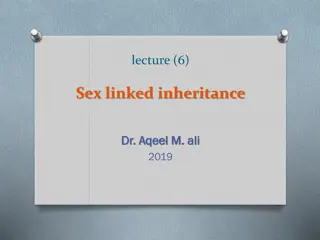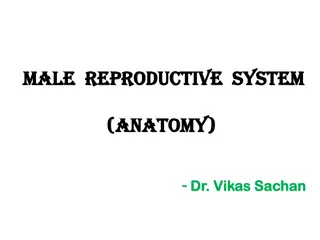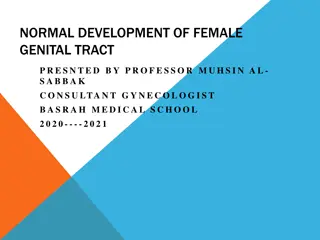Understanding Sex Determination in Organisms
Sex determination in organisms involves the differentiation of male and female sexes based on gamete production, reproductive structures, and secondary sexual characteristics. This process can vary across different species, with mechanisms such as sex chromosomes, genic balance, haploidy, and single gene effects playing crucial roles. Dioecious organisms exhibit distinct sex chromosomal determination systems, including heterogametic males and heterogametic females. The presence of both sexes in a single organism, known as hermaphroditism, and the significance of primary and secondary sexual characters are also explored in this comprehensive overview.
Download Presentation

Please find below an Image/Link to download the presentation.
The content on the website is provided AS IS for your information and personal use only. It may not be sold, licensed, or shared on other websites without obtaining consent from the author. Download presentation by click this link. If you encounter any issues during the download, it is possible that the publisher has removed the file from their server.
E N D
Presentation Transcript
lecture (5) Determination of sex Dr. Dr. Aqeel M. Aqeel M. ali 2019 ali
The word sex has been derived from Latin word sexus meaning section or separation. Members of almost all species are often divided into two sections according to the kind of gamete or sex cell produced by them, i.e., male sex and female sex. some of the lowest forms of plant and animal life are found to have several sexes. ciliated protozoan Paramecium bursaria there are eight sexes or mating types all morphologically identical. Each mating type is physiologically incapable of conjugating with its own type, but may exchange genetic material with any of the seven other types within the same variety.
both sexes are present in the same organism, a condition termed hermaphroditism organisms that bear both male and female reproductive structures are monoecious one house . In plants where staminate (male) and pistillate (female) flowers occur on the same plant, the term of preference is monoecious. Most of our flowering plants have both male and female parts within the same flower (called perfect flower). Species in which the organism has either male or female reproductive structures are said to be dioecious (meaning two houses ).
The sex cells and reproductive organs form the primary sexual characters The male and female sexes differ from each other in many somatic characters known as secondary sexual characters. The phenomenon of molecular, morphological, physiological or behavioral differentiation between male and female sexes is called sexual dimorphism.
mechanisms of sex determination 1. Sex chromosome mechanism or Heterogamesis; 2. Genic balance mechanism; 3. Male haploidy or haplodiploidy mechanism; 4. Single gene effects.
TYPES DETERMINATION In dioecious organisms following two systems of sex chromosomal determinationof recognized: OF SEX CHROMOSOMAL MECHANISM OF SEX (a) Heterogametic males; (b) Heterogameticfemales. Heterogametic Males In this type, the female sex has two X chromosomes, while the male sex has onlyone X chromosome. During gametogenesis gametes, 50 % carry the X chromosomes, & 50 % gametes lack in X chromosomes. Such a sex which produces two different type of gametes in terms of sex chromosomes is called heterogametic sex. The female , produces similartype of gametes, is called, homogametic
The heterogametic males may beof following two types: (i) XX-XO sexdetermination by McClung in the grasshoppers and insects specially those of the orders Hemiptera (true bugs) and Orthoptera (grasshoppers and roaches). In this system : Females males the letter O signifies theabsenceof a sex chromosome. In meiosis in females, the twoX chromosomes pairand then separate, with one X chromosomeentering each haploid egg. In males, the single X chromosome segregates in meiosis to half the . sperm cells; theother half receive no sex chromosome. have two X chromosomes (XX) possess a single X chromosome (XO).
The sex of the offspring depends upon the sperm that fertilizes the egg. In the XX-XO system, the sex of an individual organism is therefore determined by which type of male gamete fertilizes the egg. X-bearing sperm unite with X-bearing eggs to produce XX zygotes, which eventuallydevelop as females. Sperm lacking an X chromosome unite with X-bearing eggs to produce XO zygotes, which develop into males.
(ii) XX-XY sex determination : In insects(Drosophila ) , reptiles, and all mammals (including humans ) males and females have the same number of chromosomes, but female possesses two X chromosomes in their body cells hence, referred to as( XX) and they being homogametic, produce one kind of eggs, and the cells of males have a single X chromosome and a smaller sex chromosome, the Y chromosome (XY). In humans and many other organisms, the Y chromosome is acrocentric not Y shaped as is commonly assumed. In this type of sex-determining system, the male is the heterogametic sex half of his gametes have an X chromosome and half have a Y chromosome. The sex of embryo depends on the kind of sperm. An egg fertilized by a X-bearing sperm, produces a female, but, if fertilized by a Y-bearing sperm, a male is produced many species, Many organisms, including some plants, the
heterogametic Females In this type of sex chromosomal determination of sex, the male sex possesses two homomorphic X chromosomes, therefore, is homogametic and produces single type of gametes, each carries a single X chromosome. The female sex either consists of single X chromosome or one X chromosome and one Y chromosome. The female sex is, thus, heterogametic and produces two types of eggs, half with a X chromosome and half without a X chromosome (with or without a Y chromosome). To avoid confusion with that of XX-XO and XXXY types of sex determining mechanisms, instead of the X and Y alphabets, Z and W alphabets are generally used respectively. The heterogametic females may be of following two types :
(i) ZO-ZZ system This system of sex determination is found in certain moths and butterflies. In this case, the female possesses single Z chromosome in its body cells (hence, is referred to as ZO) and is heterogametic, producing two kinds of eggs, half with a Z chromosome and half without any Z chromosome. The male possesses two Z chromosomes (hence, referred to as ZZ) and is homogametic producing single type of sperms, each of which carries a single Z chromosome. The sex of theoffspring depends on the kind of egg as shown below : Parent : Female 2A+ZO Gametes : (A+Z) (A+O) Ova F1 : 2A+ZZ , X Male 2A+ZZ (A+Z) (A+Z) Sperms 2A+ZO Female Male,
(ii) ZW-ZZ system. This system of sex determination occurs in certain insects (gypsy moth) and vertebrates such as fishes, reptiles and birds and plants such as Fragaris elatior. Here the female sex has one Z chromosome and one W chromosome. It is heterogametic and produces two types of ova, 50 per cent ova carry the Z chromosomes, while rest 50 per cent ova carry W chromosomes. The male sex has two homomorphic Z chromosomes and is homogametic producing single type of sperms, each carries a Z chromosome. The sex of the offspring depends on the kind of egg, the Z bearing eggs produces males but the W bearing eggs produce females . Parent : Female 2A+Zw (A+Z) (A+w) Ova X Male 2A+ZZ Gametes : (A+Z) (A+Z) Sperms 2A+Zw Male, F1 : 2A+ZZ , Female
2- Genic Balance Mechanism some genes carried by the sex chromosomes (X and Y) were entirely responsible for sex. But this is not the case. Experiments of different workers (Wilson, 1909 ; Bridges,1921 and Goldschmidt, 1934) on different organisms revealed the fact that most organisms generally have inherent potentialities for both individual is found to be more or less intermediate between male and female sexes (Hence may be referred to as intersex). first of all studied in Drosophila by C.B. Bridges in 1921. sexes and each
theory of genic balance given by Calvin Bridges (1926 states that instead of XY chromosomes, sex is determined by the genic balance or ratio betweenX-chromosomes and autosomegenomes. 1926) In this system, a number of different genes influence sexual development. The X chromosome contains genes with female-producing effects, whereas the autosomes contain genes with male-producing effects. Consequently, a fly s sex is determined by the X : A ratio , the number of X chromosomes divided by the number of haploid sets of autosomal chromosomes
Sex determination in Drosophila. In Drosophila, the presence of Y chromosome has been found essential for the fertility of malesex but that has nothing to dowith thedetermination of malesex. In this fly, the sex is determined polygenically. The sex of an individual then dependsupon the ratioof X chromosomes toautosomes. Drosophila melanogaster has eight chromosomes: three pairs of autosomes and one pair of sex chromosomes. Thus, it has inherited one haploid set of autosomes and onesex chromosome from each parent. Normally, females have two X chromosomes and males have an X chromosome and aY chromosome. the presence of the Y chromosome does not determine maleness in Drosophila; instead, each fly s sex is determined by a balance between genes on the autosomes and geneson the X chromosome.
1) X : A ratio of 1.0 produces a female 2) X : A ratio of 0.5 produces a male 3) X : A ratio between 1.0 and 0.5 produces an intersex fly, with a mixture of male and female characteristics. 4) X : A ratio is less than 0.5, a male phenotype but the fly is weak and sterile sometimes called meta males. 5) X : A ratio is greater than 1.0, a female phenotype is produced, but this fly (called a meta female) has serious developmental problems and many never complete development.
Table presents some different chromosome complements in Drosophila and theirassociated sexual phenotypes. --------------------------------------------------------------------------- Normal females have two X chromosomes and two sets of autosomes (XX, AA), and so theirX : A ratio is 1.0. Males, on the other hand, normally have a single X and two sets of autosomes (XY, AA), and so theirX : A ratio is 0.5. Flies with XXY sex chromosomes and two sets of autosomes (an X : A ratio of 1.0) develop as fully fertile females, in spite of the presence of a Y chromosome. Flies with only a single X and two sets of autosomes (XO, AA, for an X : A ratio of 0.5) develop as males, although they are sterile. These observations confirm that the Y chromosome does not determine sex in Drosophila.
Triploid (female) diploid male 3A+XXX 2A+ XY A+X A+Y Triploid female Triploid intersex 2A+XX 3A+XXX Diploid female 3A+XXY Diploid male A+X 2A+XX Triploid intersex 2A+XY Super male 2A+x 3A+XX 3A+XY A+XX Super female Diploid female 2A+XXX 2A+XXY Fig. Results obtained from a Bridge s classical cross of a triploid (3A+XXX) female fly and a diploid (2A+XY) male fly (Drosophila).
3- Male Haploidy or Haplodiploidy Mechanism Male parthenogenesis hymenopterous insects such as ants, bees, sawflies and wasps In these insects, since, fertilized eggs develop into diploid females and unfertilized ones into haploid males; so arrhenotoky is both a form of reproduction and a means of sex determination. Meiosis is normal in females, but crossing over and reduction in chromosome number fail to occur during spermatogenesis in males due to their haploidy haploidy or is haplodiploidy particularly arrhenotokous common or in the
* Forexam ple,ahoneybeequeen(w hosediploidnum beris 32)canlaytw otypesofeggs. BB y controllingthesphincter of her spermreceptacle (w hichholdssperm spreviouslyobtainedinm atingsw ith m alesduringnupitalflight), sheproduces a fertilized egg (adiploidzygotehaving32chrom osom esanddevelopingintoafem ale) oran unfertilizedegg (ahaploidzygotehaving16chrom osom esanddevelopingintoam ale). Thediploidfem alezygotescandifferentiateintoeither w orkers(sterile)orqueens(fertile)dependingonthediet theyconsum eduringtheirdevelopm ent.
4-Single Gene Control of Sex In certain Neurospora, yeast, Asparagus, maize, Drosophila, etc., individual single genes are found to be responsible for the determination orexpression of sex, following cases exemplified the single gene control of sex : (a) Sex-determination in Asparagus. Asparagus is a dioecious plant, however, sometimes the female flowers bear rudimentaryanthers and the male flowers bearrudimentary pistils. Thus, sometime when the seeds of such a rare male flower were raised into plants, then, the male and female plants were found to be present in 3 : 1 ratio. When the male plants raised thus were used to pollinate the female flowers on female plants, only two third of them showed segregation indicating that the sex is controlled by a singlegene. organisms, for example Chlamydomonas,
Rare male plant Pp Selfed PP Pp (25%) Female PP (% 25)MALE 50% male Asparagus showing monogenic control. Segregation for sex in seed obtained from a rare bisexual flower in























